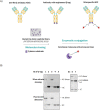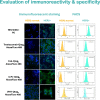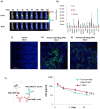Antibody and antibody fragments site-specific conjugation using new Q-tag substrate of bacterial transglutaminase
- PMID: 38360912
- PMCID: PMC10869684
- DOI: 10.1038/s41420-024-01845-3
Antibody and antibody fragments site-specific conjugation using new Q-tag substrate of bacterial transglutaminase
Abstract
During the last few years Antibody-Drug Conjugates (ADCs) have become one of the most active and very promising therapeutic weapons. Lessons learned from the traditional chemical conjugations (via lysine or cysteine residues of the antibodies) and the clinical studies of the developed ADCs have recently paved the way to the improvement of the conjugation technologies. Use of site-specific conjugation is considered as the promising path for improving the design and development of homogeneous ADCs with controlled Drug-Antibody ratio (DAR). Moreover, some of these conjugations can be applied to antibody fragments such as Fab, scfv and VHH for which random and chemical conjugation showed significant limitations. In this study, we identified a novel small peptide substrate (Q-tag) with high affinity and specificity of bacterial transglutaminase which can be genetically fused to different formats of antibodies of interest for the development of enzymatic site-specific conjugation we named "CovIsolink" platform. We describe the synthesis of chemically defined drugs conjugation in which the site and stoichiometry of conjugation are controlled using a genetically encoded Q-tag peptide with specific amino acids which serves as a substrate of bacterial transglutaminase. This approach has enabled the generation of homogeneous conjugates with DAR 1,7 for full IgG and 0,8 drug ratio for Fab, scfv and VHH antibody fragments without the presence of significant amounts of unconjugated antibody and fragments. As a proof of concept, Q-tagged anti Her-2 (human IgG1 (Trastuzumab) and the corresponding fragments (Fab, scfv and VHH) were engineered and conjugated with different aminated-payloads. The corresponding Cov-ADCs were evaluated in series of in vitro and in vivo assays, demonstrating similar tumor cell killing potency as Trastuzumab emtansine (Kadcyla®) even with lower drug-to-antibody ratio (DAR).
© 2024. The Author(s).
Conflict of interest statement
The authors declare no competing interests.
Figures






References
Grants and funding
LinkOut - more resources
Full Text Sources
Research Materials
Miscellaneous

